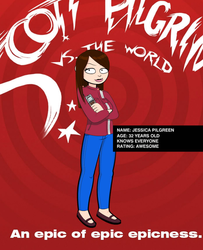 SMORE is a new online program that allows you to design dynamic online newsletters for free. (ah, free! one of my favorite words, especially when it comes to education!) Right now, you have to request membership and wait to be approved before you can use Smore, but it is well worth the wait! Although Smore bills itself as a tool for creating flyers, it could be used to create any sort of web document; this would be an excellent site for creating a classroom webpage or a class/school newsletter. The themes are beautiful and simple, giving the pages a clean and modern look. Editing content is as easy as using Power Point, so even the web novice would be able to build online documents with ease. More experienced with building web pages? Try spicing up your newsletter by embedding pictures, links, or videos. Another great feature is that viewers can leave comments on the newsletter through Facebook, creating real-time feedback from viewers. NOTE: I'm currently using Smore to build the newsletter for the members of my local chapter of the National Writing Project. You can view my document HERE. A Cupcake Story from Smore on Vimeo.
2 Comments
For Internet safety reasons, I do not want my students using actual photos of themselves online. Instead, I've been compiling a list of websites that I can direct my students to where they can create fun avatars. Click on an image below for the web address where the avatar was created, or click on the hyperlinks below the images. All of the avatars below were created by me after "playing" with the websites, so I have tested each of them personally. All of the avatar creators are completely free, and none of them require any downloading. In addition to creating avatars for Internet safety when participating in web publishing, discussion boards, and social networking, avatar can also be animated for presentations. Voki allows user to add audio files to avatars. Picture files can also be manipulated with a website such as Blabberize, or a paid program like CrazyTalk. Note: Some website may contain unsuitable items (for example, the South Park avatar creator allows users to add alcoholic beverages to their avatar). Preview the website that you plan to use in order to make sure that it is appropriate for your students. Top Row (L-R): South Park Avatar, Simpsons Avatar, Mii Avatar Middle Row (L-R): Scott Pilgrim Avatar, Diary of a Wimpy Kid Avatar, Anime Avatar Third Row (L-R): Voki Avatar (talking avatar), Stick Person Avatar, Mad Men Avatar Bottom Row (L-R): WeeMee Avatar, Doppel Me Avatar, FaceYourManga Avatar  My Fake Wall allows user to create fake Facebook walls for fictional (or nonfictional) characters. The fake wall to the left is from the website's "Favorite Fake Walls." This would make an excellent exercise for introducing characterization. I would love to see a chemistry teacher have students create fake walls for different chemicals, or see a math teacher have students create walls for different geometric shapes or theorems.  Edmodo is, to put in simplest terms, Facebook for education. Students will find it easy to use because they are already familiar with the format. Post questions and let your students respond. Upload files, administer polls, share links, subscribe your learners to RSS feeds--there are TONS of possibilities! Organize with ease by grouping students by class. Let students respond to each other's posts as a wonderful way to brainstorm ideas and gather feedback. You can also create and maintain a class calendar. Edmodo is completely safe and secure, and students can even access it from their Smart phones. For more information on Edmodo, visit their FAQ page here.  Gaggle is a free program that offers secure e-mail addresses for students. Other features include chat rooms, discussion boards, blogs and even safe texting (so that teachers and students can text without publicizing their phone numbers). Gaggle will notify the administrator if inappropriate content is sent. Accounts can be created for teachers, students, and even parents. Gaggle also offers digital lockers for storing files, as well as assignment drop boxes.  ePals also offers free, safe e-mail for students and teachers. Additionally, ePals is a community which will facilitate correspondence between teachers to set up classroom pen pals. I have not used this service personally, but I did attend one of their free online webinars in order to learn more about them, and it seemed like a very exciting learning opportunity.  Wallwisher essentially allows you and your students to create virtual sticky notes in a shared space. This could function as a discussion board, or could be used as a brainstorming activity. You could also post a poll and have students post responses. The possibilities for this application seem endless. If you want to collect student feedback including text, images, or files, try using Wallwisher. There's nothing to download and students don't have to create an account. Check out some Interesting Ways To Use Wallwisher on Tom Barrett's blog. |
AuthorDr. Jessica Pilgreen, Ed.D. Archives
December 2020
Categories
All
|













